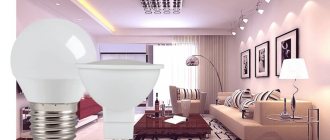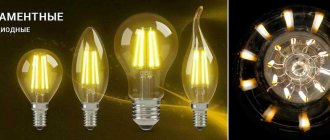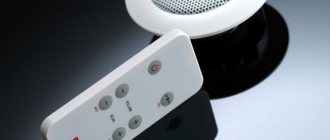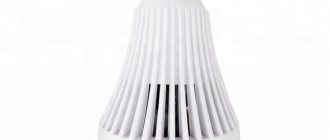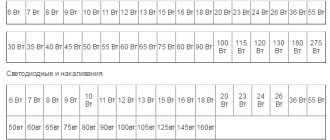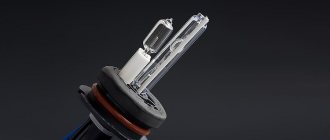Incandescent lamps are becoming a thing of the past. The reason for this was low efficiency and fragility compared to modern lighting sources. Now at the peak of popularity are 220V LED lamps, which have many advantages. It is difficult to understand the huge range of LED devices without preparation. Do you agree?
We will talk about how to choose diode light bulbs to optimize your home lighting network. Our article describes in detail the types and characteristics of LED devices. A decoding of the markings is given, and recommendations are given to help you find the required option.
Features of LED lamps
Modern LED lamps are more complex than their incandescent filament predecessors. To operate LEDs, a number of electronic components are required, which are located on a printed circuit board.
All structural elements are compactly hidden inside the case. The light sources themselves take up a minimal amount of space in the lamp.
The weak point of inexpensive LED lamps is the capacitors, the low quality of which leads to pulsating light. In addition, they can burn out before the LEDs themselves.
The design of a standard LED lamp includes the following components:
- Light diffuser made of plastic. Promotes uniform distribution of light flux in all directions around the lamp.
- Printed circuit board with capacitors, voltage converters and other electronic components.
- LEDs. Their number and operating voltage are in strict accordance with the built-in electronic circuit.
- Aluminum radiator designed to remove heat from high-power lamps.
- Ventilation slots provide passive cooling of the board and LEDs.
- The socket with which the lamp is attached to the lamp.
Thus, an LED lamp is a device with a complex internal structure. It is demanding on external temperature and power supply parameters.
Types of LED light sources
All LEDs can be divided into two large categories: indicator and lighting. The first type is used in electrical engineering for illuminating instrument panels, displays, signal indications, as well as in other devices that do not require a large luminous flux.
And lighting LEDs are used just in household LED lamps. Such lamps can be classified according to their purpose, external structure and type of radiation sources.
By area of use
LED lamps are capturing more and more technological niches. They are used in consumer electronics, industrial and commercial equipment.
LED spotlights for street lighting are made mainly on the basis of one large LED, so it is not possible to adjust their brightness
The main areas of application of LED lamps are:
- Street lighting.
- High performance floodlights.
- Lighting of industrial premises and apartments.
- Agriculture. Lamps with a radiation spectrum capable of initiating photosynthesis are used.
- Car lights.
- Illumination of products in shop windows.
- Space lighting in explosive environments.
A large number of areas of use of LED lighting are due to differences in the characteristics of LEDs and the spectrum they emit. Innovative types of lamps are constantly being developed to fill new market niches.
By appearance
One of the reasons for the prevalence of LED lamps is the minimal size of their semiconductor crystals. Thanks to this, lamps can take on a wide variety of shapes.
It is not recommended to install high-power LED devices in places with limited air circulation - this may cause the LED to overheat
The main designs of LED lamps are:
- Classic design like an incandescent lamp with a base. Such lamps usually contain several multi-directional LEDs.
- "Corn". This lamp looks like a cylinder covered on all sides with LEDs.
- Ribbon-shaped LED lamps in which individual crystals are arranged in series on a narrow, thin substrate.
- Spotlights with one large luminous crystal.
- Spot ceiling lights.
- Flat LED panels of round, rectangular or arbitrary shape.
The small size and unpretentiousness of LEDs to the installation site allows them to be used to produce designer lamps of unusual shapes. And the low heating of LED lamps does not prevent their placement near plasterboard and plastic surfaces.
By LED type
Lighting LEDs are divided according to their physical structure into several types, each of which has its own characteristics and predominant areas of application.
LED lamps are manufactured in three main types:
- SMD (surface mount LEDs).
- COB (device on a chip).
- Filament (LED filament).
Surface-mount LEDs have low luminosity, but they can be independently soldered to any surface without fear of overheating.
Therefore, they are often used in the manufacture of LED strips and portable lights. The radiation angle of SMD LEDs is 90-130 degrees, so to illuminate the entire room around the lamp, a radial arrangement of crystals on the base is necessary.
The power of an LED lamp with LED filaments depends on the number of glass fibers, their length and the characteristics of the crystals placed on them
COB LEDs are high-luminosity crystals placed on a metal substrate. It is designed to remove heat generated during operation.
The emission angle of on-chip devices approaches 180 degrees, making them poorly suited for highly targeted lighting. COB is used in the production of floodlights and premium lamps.
LED filaments are a series of miniature crystals placed in series on a glass fiber. Sometimes other transparent materials are used instead of glass. This structure allows for uniform circular lighting.
The main problem with high-power small LEDs is overheating, which reduces their service life and luminous flux levels.
Calculation of a resistor for an LED in parallel connection
Serial connection of LEDs
If the master connects a 12 Volt LED in a series circuit, the lamps are assembled in a chain. In this case, the cathode of each previous element is soldered to the anode of each next one.
With this assembly scheme, a current of 20 mA passes through all the bulbs. The voltage level here also consists of the sum of the Volt drop across each of them. Thus, it is forbidden to connect an arbitrary number of light bulbs to one circuit.
If you need to connect a large number of LED lamps in series, you need to take a power source with high voltage and power ratings.
The disadvantages of serial connection include:
- Failure of the entire light chain if one element breaks down.
- The need to purchase a more powerful power supply when installing a large number of lamps.
The minus of the LED is connected to the plus of the next one. This way you can connect ad infinitum. With this connection, the voltage drop across the LED is multiplied by the number of diodes in the circuit. Those. if we have 5 LEDs with a rated current of 700 mA and a voltage drop of 3.4 Volts, then we need a driver for 700 mA 3.4 * 5 = 17 V
We have looked at what drivers can be selected, and now we will return directly to how to calculate the resistor for an LED with such connections.
Above we looked at the calculation of a resistor for an LED (one). For a series connection, the calculation is similar, but it must be taken into account that the voltage drop across the resistor is smaller. If “on fingers”, then the total voltage drop across the LEDs Vl=3*2=6V is subtracted from the power source. Provided that our source produces 12V, then 12-6 = 6V.
R=6/0.02=300 Ohm.
Р=6*0.02=0.12W
Those. we need a 300 ohm and 0.125 watt resistor.
The characteristics of the LED and power supply are similar to the previous example.
With this connection, the plus of the LED is connected to the plus of the other, and the minus to the minus. With this connection, the current is summed, but the drop remains unchanged. Those. if we have 3 LEDs of 700 mA and a drop of 3.4 V, then 0.7 * 3 = 2.1A, then we will need a driver with parameters of 4-7 V and at least 2.1A.
The calculation of the resistor for the LED in this case is similar to the first case.
Interesting connection. With this arrangement of diodes, several serial chains are connected in parallel. You need to know that the number of LEDs in the chains must be equal. The driver is selected taking into account the voltage drop on one circuit and the product of the current by the number of circuits. Those.
The resistor is similar for a series connection, however, it is worth considering that the consumption from the power source will increase three times (0.2 0.2 0.2 = 0.06A).
When connecting LEDs through a resistor, you need a stabilized power source, because When the voltage changes, the current flowing through the diode will also change.
There is another way to connect LEDs - parallel-series with cross connection. but this is a rather complex topic in calculations, so I will not reveal it here. If necessary, of course, I will describe it, but I think this is only needed by a narrow circle of specialists.
You can find many online calculators on the Internet that will immediately calculate resistors for you. But you shouldn’t blindly believe them, but rather double-check, following the saying: “If you want to do it well, do it yourself.”
Advantages and disadvantages of LEDs
Until recently, fluorescent lamps were at the top of their popularity, but within a few years they were supplanted by LED lamps.
In recent years, LED lighting has gained the lion's market share due to many consumer advantages, among which are the following:
- Economical . New LED lamps consume 9-10 times less electricity than incandescent lamps with similar luminous flux.
- Durability . The continuous service life of good LEDs is calculated in years, although their luminosity decreases somewhat over time.
- High efficiency , due to which the lamps practically do not heat up.
- Safety . If the LED lamp is damaged, no sharp fragments are formed and no harmful substances are released. There is no UV radiation in the emitted flux.
- Possibility of adjusting color temperature.
- High durability of LEDs.
- Adjusting the brightness of the glow.
- Operability in a wide temperature range.
- A wide range of . Possibility of producing lighting fixtures of any shape.
The numerous advantages of LED lamps contribute to the massive transition of consumers to these lighting sources.
To ensure yourself the full benefits of LED lamps, you should buy models from famous brands that guarantee the quality of their products
However, LED lamps also have their disadvantages, which should be kept in mind when purchasing:
- Expensive. The cost of cheap LED lamps is 4-5 times higher than incandescent lamps.
- The use of frosted bulbs degrades the visual effects of crystal chandeliers.
- A rapid drop in luminosity with regular overheating.
- Light flicker in cheap models, which negatively affects vision and general well-being.
- Unidirectionality of light, which forces the use of a radial arrangement of LEDs.
- Electronic components of cheap LED lamps break down faster than the crystal burns out, which shortens the actual service life.
- Incorrect operation when connected to a switch with an indicator.
Despite the disadvantages of LED lamps, the population continues to buy them. Real savings are achieved only in 3-4 years and only if all purchased lamps are in working order. Therefore, the feasibility of their purchase is still worth assessing.
Advantages and disadvantages of LED lamps.
pros
- energy efficiency - power consumption is 8-10 times less than incandescent lamps;
- long service life - they shine about 25 times longer than incandescent lamps;
- practically do not heat up;
- a wide selection of color temperatures allows you to “play” with interior lighting;
- stable brightness during voltage fluctuations;
- instant on;
- the number of starts does not affect performance;
- resistance to mechanical damage and vibration;
- Possibility of use in a “smart home”;
- excellent decorative qualities - available in many interesting shapes and sizes;
- do not attract midges and other insects due to the lack of ultraviolet light;
- safe disposal and operation due to the absence of hazardous substances.
Minuses
- relatively high cost, although it is constantly decreasing;
- flickering (pulsation), which is invisible to the naked eye, but very dangerous for vision (more common in cheap models, which are often produced without a driver);
- design complexity leads to increased cost and decreased reliability compared to incandescent lamps;
- unsuitable for use at very low and very high temperatures;
- in many models, the brightness cannot be adjusted using a dimmer;
- if a backlit switch is used, the LED lamp may flicker or glow when turned off (how to avoid this, read the article “Why does the LED lamp blink”);
- decrease in brightness during operation;
- a high percentage of defects among products, especially among inexpensive ones.
In conclusion, it is worth noting that LED light sources are truly economical lighting devices. Just before choosing, you need to carefully study the technical specifications.
Firstly, they are economically feasible to replace incandescent lamps with a power of over 60 W. Otherwise, the cost of the LED lamp itself will not pay off.
Secondly, it is worth replacing only light sources in lamps that operate the maximum number of hours per day.
And thirdly, experts advise first trying out several brands of LED lamps to determine whose color temperature (and other parameters) will suit your eyes 100%.
- Related Posts
- Lamps with e27 base: the most powerful, advantages and disadvantages
- LED dimmer 220V
- Let's figure out what it is and what types of outdoor lighting there are for country houses and cottages
Selection of LED lamps by characteristics
The operation of LED lamps with a voltage of 220V is characterized by more than ten technical parameters. Awareness about them will help you buy lamps that will best meet your lighting needs and ensure long-term operation of LEDs.
Nominal luminous flux
The luminous flux of lamps can be analyzed both in nominal units (lumens) and in relative units (lumens/watt). The higher the power of the LED, the brighter the emitted beam of light.
Fluorescent lamps are sensitive to frequent switching on and off, so their use in walk-through rooms quickly leads to breakdown
However, the ratio of luminous flux to 1 W of energy consumed is more important.
It differs between different manufacturers:
- for European, Japanese and branded Chinese - 110-125 Lm/W;
- for cheap Chinese ones - 60-80 Lm/W;
- from the largest international suppliers using COB technology – 180-190 Lm/W.
It is recommended to buy LED lamps after carefully studying the characteristics of the devices. We recommend paying attention to the highest luminous flux per 1 W of power. They are more economical, more durable, and do not cost much more.
Maximum power consumption
The luminous flux they emit directly depends on the level of power consumption of LED lamps. Within one model range, this relationship is almost linear.
Due to the fact that the LEDs themselves take up minimal space in the lamp, its power can be easily increased without changing the shape of the housing only by increasing the number of crystals.
But since the ultimate goal of purchasing lamps is still a sufficient level of illumination in the room, sometimes it is better to buy one reliable, expensive LED device than two cheap ones. Their luminous flux will be equal, but their power consumption will differ by a factor of two.
Color temperature level
The color temperature of LED lamps determines the shade of light they emit. It can range from yellow to white. Each color has a different effect on a person. Lamps with warm yellow light have a temperature of 2600-3200K and promote relaxation. They are recommended to buy for home.
In rooms with yellow walls, it is recommended to use LED lamps with a temperature of about 4000K so that the white light emphasizes the interior elements
Lamps with a temperature of 6000K have a cool white color with a blue tint and increase efficiency. They are installed in offices, industrial premises, and also at the desktop.
There are also lamps that emit neutral white light. Their temperature is 3700-4200K, and they provide an emission spectrum that is as close as possible to daylight.
Type of lamp base
When changing incandescent lamps to LED, it is important to pay attention to the base of the diode device. The most common screw-in versions are E27 and E14, as well as with 2 pins - GU5.3, GU10 and GU13. When purchasing, it is recommended to take your old lamps to the store and show them to the seller so that he can suggest suitable LED models.
Purchasing a lamp with an incorrectly shaped base requires returning to the store, processing the return of the lamp and purchasing a suitable model
Manufacturers of LED lamps have also taken care of the owners of old fluorescent tubes. Replacement LED analogues are available for them, which have the same dimensions and connectors. They can be built into existing luminaire housings.
Operating temperature range
LED lamps are sensitive to overheating, so it is important to take into account their operating temperature written on the packaging.
The heating of lamps is influenced by the following factors:
- The lamp has a cap.
- Room temperature.
- Distance from the ceiling to a spotlight mounted on drywall.
- The presence of an aluminum radiator in the lamp itself.
- Short-term increases in temperature in a room, for example in the kitchen when cooking.
LED lamps of a special design are sold for work in conditions of elevated temperatures. It is recommended to buy them if you want to avoid the negative impact of overheating on the LED.
Light pulsation
The light of good LED lamps should not pulsate at all, because blinking with a frequency below 300 Hz has a negative impact on human health. There are several ways to determine the instability of the light flux.
The pulsation of LED lamps on the phone screen may appear as horizontal stripes. The high frequency of blinking by the camera matrix is not registered
The first method is visual: you need to look at the lamp directly or with peripheral vision. In the second method, a smartphone camera is pointed at the lamp and its blinking on the screen is detected.
Ripple is detected mainly in cheap models equipped with a simple control unit. Expensive lamps do not have this drawback.
Degree of protection of the case
LED lamps, which operate 24 hours a day, last the longest. Therefore, the greatest efficiency can be achieved from lamps placed outdoors. However, they must be protected from moisture and dust to prevent their internal electronic components from being damaged.
The filling of LED lamps intended for outdoor use must be well insulated from the external environment. For yard lighting, the degree of protection IP54 and higher will be sufficient. Such lamps can withstand heavy rain and dusty winds.
Light Beam Angle
LEDs are always attached to a substrate that prevents light from reaching its back side. Therefore, without special devices, one emitting crystal can effectively illuminate only the space in front of it.
When marking LED lamps, the value of the angle at which half of the luminous flux falls is also used. It characterizes the light scattering of the cap
To increase the illumination angle, special diffusing caps are used. But there are also LEDs on glass fibers or transparent substrates, which make it possible to illuminate the entire surrounding space evenly.
In flashlights, on the contrary, the LED beam must be narrowed, which is achieved mainly through a special reflector. Therefore, the choice of the shape of the LED lamp should be made only after determining the required angle of luminous flux.
How to determine LED polarity
Determining LED polarity by appearance
All 12 volt LEDs (white, red, blue and other colors) have an anode and a cathode (polarity). These must be taken into account when connecting LEDs. Polarities can be determined in one of the following ways:
- By design. One of the legs on the light bulb base is always several mm longer. This is the anode. It is marked with a “ ” icon or a green dot.
- One bowl inside the flask. If you look closely, you can see two crystals on it. The larger one represents the cathode. The smaller one is the anode.
- Using a multimeter. To do this, the device must be set to “Dialing” mode. Then the probes of the device are brought to the cathode and anode. The first one is black, the second one is red. When they are positioned correctly, the light bulb should glow. If this does not happen, it means that the wizard incorrectly identified “ ” and “-”. The position of the probes needs to be changed. If this does not help, the LED is simply faulty.
Tips for choosing LED lamps
When purchasing LED devices, it is important to pay attention to both their technical characteristics and a number of other nuances.
The best way to choose an LED lamp that is comfortable for the eyes is to turn on several models in the store at the same time and compare their luminosity
The tips presented will help you purchase a high-quality lamp that will last a long time and be comfortable for the eyes.
- The packaging of LED lamps must contain an inscription stating that there is no pulsation.
- The luminous flux must be greater than that of the incandescent lamp being replaced.
- It is recommended to compare the glow of lamps of the same power in the store.
- If you have a switch with an indicator, it is advisable to first make sure that LED lamps work correctly with it.
- Ceiling lamps with a small beam angle can cause glare.
- It is recommended to buy lamps from large stores that provide a minimum of 2 years of warranty.
It is advisable to purchase lamps only from well-known manufacturers, because products from cheap, little-known brands often do not correspond to the characteristics stated on the packaging.
Scientific forum dxdy
| To page 1 , Next |
| Print page | Print entire topic | Prev. topic | Track. subject |
| alexey007 | LED lamp resistance 02.01.2013, 22:28 |
| EEater | Re: LED lamp resistance 06.01.2013, 20:41 |
| ||||||||||||||||||||||||||||||||||||||||||||||||||||||||||||||||||||||||||||||||||||||||||
| ||||||||||||||||||||||||||||||||||||||||||||||||||||||||||||||||||||||||||||||||||||||||||
LED device marking
There is no generally accepted labeling of LED lamps. Each manufacturer puts its own symbols into the model name.
These markings apply to all types of lamps and help ensure compatibility between devices with different operating principles.
But there are a number of common abbreviations that are applied to lamps, regardless of their type:
- E27, E14, E40 – screw-in base and its diameter in mm.
- GU5.3, GU10 and GU13 pin base and size in mm between pins.
- A, C, R, CA, CF, G, P, S, T – cap shape.
- A, A+, A++ – degree of efficiency.
- 2700K-6000K – color temperature.
Also, the lamp body can display general technical characteristics characteristic of an electrical device: voltage and frequency, operating temperature, power, service life in hours, luminous flux level and other parameters.
Leading manufacturers of LED lamps
World-famous manufacturers of LED products value their image, and therefore strive to produce lamps with parameters that fully correspond to the declared ones.
The best manufacturers of premium LED lamps are:
- Philips;
- Osram;
- Eurolamp;
- Gauss.
The prices for the products of the listed companies are the highest, but the quality of the lamps is excellent.
The difference in the cost of lamps of the same power from the best brands and cheap manufacturers is only 30-70%, so it is recommended to buy more reliable models
The middle price segment in the production of LED lamps is occupied by the following companies:
- Feron;
- Camelion;
- Jazzway;
- Estares;
- Era;
- Navigator;
- Ecola;
- Optogan.
These companies strive to use inexpensive components in production without severely compromising quality. Often their lamps break in the first days of operation, but are replaced under warranty without any problems.
It is not recommended to buy LED products from little-known Chinese and domestic brands, because their warranty period rarely exceeds 4-6 months. In addition, they do not care about the brand image, which means they can freely use second-class components in production.
